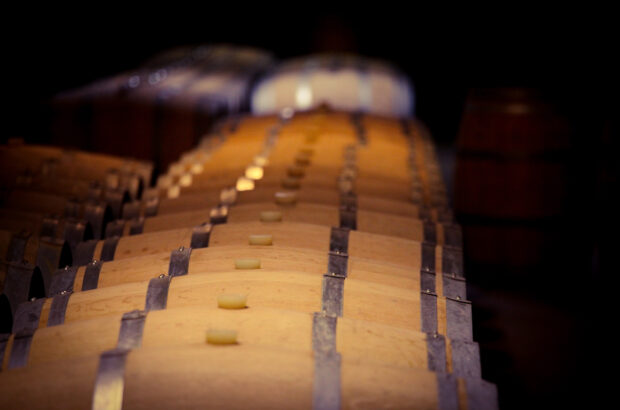Vodka has been undergoing a quiet revolution in recent years. While all eyes have been on gin, vodka producers have changed their focus. Where much noise was previously made about the number of times a vodka was distilled and filtered – removing a lot of the character from the spirit – today, the focus is on the raw material used to make it, and maintaining some of that character.
‘The skill with vodka is retaining the impurities, or characteristics, from the raw material while achieving a purity,’ says Chris Baldwin, market manager UK/Europe and brand ambassador for Crystal Head Vodka. So what are the raw materials that are used to make vodka, and what characteristics do they produce?
Vodka can be made from anything that can be used to make alcohol – namely, ingredients that contain starch and sugars. The vast majority are made from cereals and potatoes.
How vodka is made

Kirsty Black, Arbikie Master Distiller. Credit: Abertay University / PA
By its very definition, vodka is a neutral distilled spirit. The raw ingredient is first fermented to create a low-alcohol liquid known as a wash. This wash is then run through a column still – a still that is run continuously and causes multiple evaporations and condensations of the liquid – which produces a spirit of roughly 95% alcohol by volume (abv). Some producers then use water to carefully reduce the abv of the liquid to around 50%, and put this spirit through a pot still to produce a smoother spirit.
Whether a pot still is used or not, the resulting liquid is filtered through a material such as charcoal, and watered down to roughly 40% abv. Filtration can take place before or after the hydration of the spirit.
The distillation of vodka to such a high level of alcohol means that the vast majority of flavours and other characteristics are removed. Producers can also incorporate a number of other factors to try to help them achieve neutrality.
For example, Arbikie – a farm-to-glass distillery in Scotland that produces different vodkas from potatoes, wheat and peas – uses the same, relatively neutral yeast strain across all three of its vodkas. ‘For fermentation, we use a yeast strain that only produces a low level of flavour compounds, as the goal here is to not make flavour,’ explains Kirsty Black, Arbikie’s Master Distiller.
Quality counts

Tad Dorda, Chopin Vodka
Despite this supposed neutrality, however, the different raw materials used to make vodka can impart different key characteristics – and herein lies the challenge.
When working with quality raw materials, Baldwin explains: ‘You don’t want to over-distil. Crystal Head Original is a relatively short, four-column distillation.’ In contrast, a vodka made with a low-quality ingredient such as corn fructose syrup will undergo a ‘long, continuous distillation through a number of column stills’.
The Chopin distillery in eastern Poland makes three vodkas, from potatoes, rye and wheat. ‘At Chopin, we’ve always argued that pure vodka has flavour,’ says Tad Dorda, founder and CEO of Chopin Vodka. ‘For this reason, [we have] concentrated on crafting single-ingredient vodkas, in order to pay attention to the different flavours that each of these ingredients brings to the final product.’
So let’s take a look at what sort of vodkas these different ingredients produce.
Wheat
The most commonly used ingredient for vodka, 1 wheat is the predominant material used in Russian vodka, but the use of wheat can be found in most countries. Wheat vodkas are typically easy drinking. ‘Winter wheat is smooth, clean, classic with creamy vanilla and citrus notes,’ says Pleurat Shabani, creator of the Konik’s Tail brand: blended vodka made with a mix of spelt, winter wheat and rye.
Most brands declare that they use winter wheat, but what does this mean? ‘Winter wheat is sown in the autumn, lives through the winter and then is harvested in summer,’ explains Marcus Lundmark, agricultural technologist at Absolut Group. ‘It is hardy and contains more starch, which is important to produce vodka.’
Try: Absolut, Sweden
One of the iconic vodka brands, Absolut is made using winter wheat grown in Åhus, southern Sweden. The palate is soft with an icing sugar sweetness, caramel, white farmhouse loaf, cashew nuts, pine nuts and cooling anise. Alcohol 40%
Rye
Much like rye bread, rye vodkas are known for having depth of flavour and spice. ‘Rye is full-bodied, rich, it has an aniseed freshness and white pepper buzz, it presents a spiciness and oiliness and big personality,’ enthuses Shabani. Rye vodkas most commonly hail from Poland. ‘Rye gives vodka character, and rye vodka is the most traditional expression of Polish vodka,’ states Dorda.
Try: Chopin Rye Vodka, Poland
An excellent example of Polish rye vodka. The first sweet note of vanilla shortbread biscuits is soon joined by crunchy rye bread slathered in butter, a big bite of white pepper, some fennel and Golden Delicious apples. Alc 40%
Barley
‘Barley vodka is more aromatic than wheat vodka,’ declares Vadim Grigoryan, co-founder and brand director of Scottish vodka brand X Muse. When the team at X Muse experimented with barley varieties, ‘we were astonished at how different the flavours were’.
Barley vodka is generally expected to have a creamy sweetness and malty characteristic; however, a tasting with Grigoryan highlights the spectrum of flavours that can be found. Rather than use the Concerto strain – the most commonly grown barley for distillation at the moment – X Muse uses a mix of the Plumage Archer and Maris Otter varieties, marrying the orchard fruit characteristics of one with the mineral aspects of the other.
Try: X Muse, Scotland
Made from a blend of two heritage barley varieties, this vodka wears its cereal heart on its sleeve. A silky mouthfeel, big bite of malt biscuit, caramel, apples, evaporated milk and macadamia. A characterful vodka best drunk neat or in Martinis. Alc 40%
Corn
When considering corn vodka, ‘firstly it’s important to distinguish between corn and corn fructose syrup, which is becoming more commonplace’, states Crystal Head’s Chris Baldwin. ‘Corn fructose syrup is an artificial sugar made from corn syrup, so in a roundabout way it does come from corn, but it is heavily processed; it’s essentially a high yield, low-cost raw material. High-quality corn that goes through a quality production process will more than likely have a creamy, sweet, vanillin character.’ Most corn vodkas hail from North America.
Try: Crystal Head, Canada
Produced in Newfoundland from a variety of corn known as Peaches and Cream, Crystal Head’s original vodka boasts a creamy mouthfeel and flavours of vanilla, butter and corn, plus orange and lemon zest. Alc 40%
Potato
‘With vodka, the goal is to reduce flavour, [so] the texture and mouthfeel of the spirit becomes really important, and this is where potato vodkas shine. Our [Arbikie] potato spirit is silky smooth and creamy on the palate with hints of pepper and spice,’ explains Black.
Potatoes are a tricky ingredient to make vodka from – they need to be thoroughly cleaned and cooked before fermentation. The fact that potatoes are perishable means timing is key. ‘We have to plan and execute with military precision our potato distillation season,’ says Dorda.
Potato vodkas mainly hailed from Poland in the past; however there have been modern brands launched that have put other countries on the map, perhaps most notably the UK with Chase and Arbikie’s products.
Try: Arbikie Tattie Bogle, Scotland
Made from Maris Piper and Cultra potatoes grown on Arbikie’s farm, Tattie Bogle’s nose is expressive and fruity, with notes of Granny Smith apples, meringue and blackberries leading onto a smooth palate of blackberries and cream, and black pepper, followed by a drying finish. Alc 43%
Other options
There are plenty of other vodkas out there made from more unusual raw materials such as grapes, grape skins, rice, agave and even milk. Perhaps most surprisingly, there have recently been a few pea vodkas launched. One of the key drivers behind this trend is that peas are great for the environment. In fact, Arbikie has calculated that its Nadar climate-positive pea vodka saves more than 1.5kg of carbon dioxide emissions per bottle. What is clear from sampling both Nadar and the cute Pod pea vodka is that they boast vegetal aromas and flavours, automatically creating a distinctive category in their own right. The revolution looks set to continue.
Try: 5 Pod,UK
The wildest vodka this writer has ever encountered, Pod is a pea vodka with distinct vegetal, grassy notes. Flavours of green pepper, agave, terracotta and grass, and a pleasant sweetness suggest this would be excellent in Bloody Marys and Gimlets. Alc 40%






